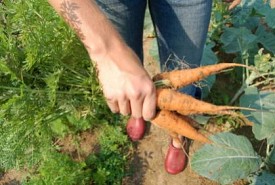Plant a Cold Climate Fall Vegetable Garden
Yes, you can grow vegetables in the fall -- even in cold climates like New England's -- whether you enlist the help of a professional gardener or make it a DIY project. Read on for practical, easy tips.
 Germinate Seedlings Now
Germinate Seedlings Now
By September, it's too late to direct seed your fall garden crops in colder climates, but you can still successfully transplant starter vegetables. Kale, greens, garlic, carrots, and beets are able to grow in cold weather, so there is still time to plant them and allow them to mature before the first hard frost. For a winter harvest, start your seedlings indoors or in cold frames, and mulch heavily with compost plus a ground cover such as dry leaves or straw.
 Prepare the Bed for Fall Plants
Prepare the Bed for Fall Plants
Prevent plant decay and disease by removing the leftover plants from summer's harvest. You can put them into your compost pile, or cut them into small pieces and till them into the ground. The small pieces of plants will help to add nitrogen to the soil. Turn over the soil with a pitchfork and add compost or compost tea.
 Build Cold Frames
Build Cold Frames
Extend your growing season by planting your fall vegetable garden in cold frames. Cold frames are mini-greenhouses. Leave them open on hot days, and keep them closed on colder days. The ones pictured here are made from wood and glass, but you can build much cheaper and quicker cold frames: Form outer walls with bales of straw, and cover the top of the straw bale walls with Reemay garden blanket. Secure the Reemay with heavy rocks.
 Cover Your Plants with Row Cover
Cover Your Plants with Row Cover
Because your plants must reach maturity before the first hard frost, ensure they stay warm. Keep your transplanted seedlings covered with Reemay day and night (unless the temperature exceeds 75 degrees), because the temperature under the row cover will be 3 to 7 degrees warmer. Floating row cover holds in the ground's heat at night, and keeps pests and bugs out by day, while allowing the sun's light to nourish the pants. It will help you conserve water by preventing evaporation.
 Check Frost Dates
Check Frost Dates
Check anticipated frost dates for your area. The Farmer's Almanac lists dates of the first light freeze in every US state. Heavily mulching your plants and covering them with floating row cover will help them to survive light and moderate freezes. A light freeze is 29 to 32 degrees Fahrenheit, and a moderate freeze is 25 to 28 degrees. Light freezes will kill delicate plants, and moderate freezes will kill fruit blossoms. Hardy plants like carrots, kale, garlic, and beets can grow in cold soil if they are properly mulched and covered.
 Plant Hardy Greens
Plant Hardy Greens
Greens like kale, collard greens, spinach, and mustard greens will grow until January if they are mulched well and covered. These veggies are flavorful, and packed with nutrients like calcium, Vitamin C, and chlorophyll. Curly kale stands up to cold better than Lacinto kale. You can plant ornamental kale in your flower garden for cold-weather color. Its purple hue is a gorgeous contrast against white snow.
 Plant Carrots
Plant Carrots
Carrots get sweeter after the first frost. Mulch the bed with six to eight inches of straw, and harvest the carrots when their roots are fully colored. Carrot seeds won't germinate in the cold, so be sure to start them somewhere warm and then transplant the little roots into your raised bed or cold frame.
 Plant Garlic Bulbs in the Fall
Plant Garlic Bulbs in the Fall
Plant garlic in the fall for harvest in the spring. Plant your cloves in mid- to late October in colder climates -- so they will grow roots before the ground freezes. Cover your garlic with 4 inches of mulch, and wait for a delicious crop. In the spring, they'll sprout delicious garlic scapes above the ground and bulbs of garlic cloves below the ground.
 Plant Beets for a Fall Harvest
Plant Beets for a Fall Harvest
Like carrots, beets get sweeter after the first frost. Stones hinder beet growth, so be sure to plant in well-tilled soil. Because beets require adequate moisture, track your fall garden's water level with a soil moisture monitor. Plant beets as early in the fall as possible -- they mature best at temperatures around 65 degrees Fahrenheit.
Looking for a Pro? Call us (866) 441-6648

Landscaping Average Costs
Landscapers Experiences

Don’t Be A Goober – Hire Qualified Pros For Safe Tree Removal

Careful, Professional Tree Service Removes A Huge Norway Maple



